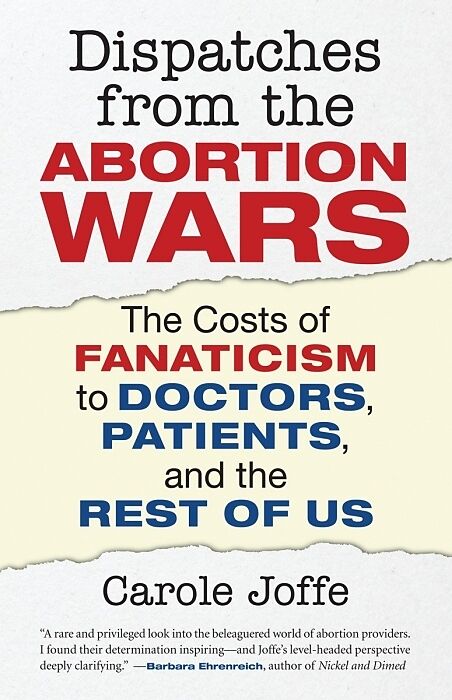Dispatches from the Abortion Wars
Einband:
Kartonierter Einband
EAN:
9780807001288
Untertitel:
The Costs of Fanaticism to Doctors, Patients, and the Rest of Us
Genre:
Sozialwissenschaften, Recht & Wirtschaft
Autor:
Carole Joffe
Herausgeber:
Beacon Press
Anzahl Seiten:
214
Erscheinungsdatum:
04.01.2011
ISBN:
0807001287
Zusatztext No one knows more about reproductive rights in the United States than Carole Joffe. This indispensable book . . . is both harrowing and galvanizing.Michelle Goldberg! author of The Means of Reproduction Terrificclear! terse! and full of things you need to know. Katha Pollitt! author of Virginity or Death! Riveting. Joffe's insights into popular culture! alongside her analysis of the recent barrage of ballot initiatives! are spot on in explaining the growth of negative attitudes about abortion.Eleanor J. Bader! Feminist Review Instructive and memorable.Emily Bazelon! Slate Informationen zum Autor Carole Joffe Klappentext Surprising firsthand accounts from the front lines of abortion provision reveal the persistent cultural, political, and economic hurdles to access More than thirty-five years after women won the right to legal abortion, most people do not realize how inaccessible it has become. In these pages, reproductive-health researcher Carole Joffe shows how a pervasive stigma-cultivated by the religious right-operates to maintain barriers to access by shaming women and marginalizing abortion providers. Through compelling testimony from doctors, health-care workers, and patients, Joffe reports the lived experiences behind the polemics, while also offering hope for a more compassionate standard of women's health care. From the Preface Cliché though it may be, there really are abortion wars raging in the United States, wars fought on numerous fronts. The front that most resembles conventional warfare involves attacks on those who provide abortions. Since the 1973 Roe v. Wade decision legalizing abortion, eight members of the abortion-providing community have been murdered, and numerous others have been stalked at their homes and churches as well as at their workplaces. Children of some providers are harassed at their schools. Antiabortion fanatics continue to this day to firebomb and vandalize clinics. Staff and patients at these clinics are subjected to constant picketing and often ear-splitting verbal harassment delivered through megaphones. As in other wars, opponents of abortion engage in intelligencegathering by videotaping those who enter abortion-providing facilities and photographing the license plates in the clinics' parking lots. But there are many other important fronts in the abortion wars. To an extraordinary degree, abortion dominates our national politics, often serving as the decisive issue in parties' choice of candidates, in the nomination of judges at all levels of the judiciary, in the selection of political appointees to serve in federal agencies. Most strikingly, during the two presidential terms of George W. Bush, an individual's stance on abortion was typically used to determine his or her fitness to serve in positions that had absolutely nothing to do with that issuefor example, a position on a drug advisory panel. The abortion wars have also had an impact on U.S. foreign policy, determining in some instances how much foreign aid a particular country will receive. At recent United Nations conferences, the U.S. delegation's fanatical opposition not only to abortion but to contraception drew scorn from other nations and often left the United States isolated. State legislatures have also been extremely consequential terrains in the abortion wars, as hundreds of regulations attempting to restrict abortion care in various ways are introduced each year. At the local level, the abortion wars are reflected in how a particular community responds to the presence, or potential presence, of an abortion-providing facility. Whether a landlord will rent or sell a suitable building, whether contractors agree to work on it, whether vendors such as cleaning services will agree to do business with a cli...
Autorentext
Carole Joffe
Klappentext
Surprising firsthand accounts from the front lines of abortion provision reveal the persistent cultural, political, and economic hurdles to access
More than thirty-five years after women won the right to legal abortion, most people do not realize how inaccessible it has become. In these pages, reproductive-health researcher Carole Joffe shows how a pervasive stigma-cultivated by the religious right-operates to maintain barriers to access by shaming women and marginalizing abortion providers. Through compelling testimony from doctors, health-care workers, and patients, Joffe reports the lived experiences behind the polemics, while also offering hope for a more compassionate standard of women's health care.
Leseprobe
From the Preface
Cliché though it may be, there really are abortion wars raging in the United States, wars fought on numerous fronts. The front that most resembles conventional warfare involves attacks on those who provide abortions. Since the 1973 Roe v. Wade decision legalizing abortion, eight members of the abortion-providing community have been murdered, and numerous others have been stalked at their homes and churches as well as at their workplaces. Children of some providers are harassed at their schools. Antiabortion fanatics continue to this day to firebomb and vandalize clinics. Staff and patients at these clinics are subjected to constant picketing and often ear-splitting verbal harassment delivered through megaphones. As in other wars, opponents of abortion engage in intelligencegathering by videotaping those who enter abortion-providing facilities and photographing the license plates in the clinics’ parking lots.
But there are many other important fronts in the abortion wars. To an extraordinary degree, abortion dominates our national politics, often serving as the decisive issue in parties’ choice of candidates, in the nomination of judges at all levels of the judiciary, in the selection of political appointees to serve in federal agencies. Most strikingly, during the two presidential terms of George W. Bush, an individual’s stance on abortion was typically used to determine his or her fitness to serve in positions that had absolutely nothing to do with that issue—for example, a position on a drug advisory panel. The abortion wars have also had an impact on U.S. foreign policy, determining in some instances how much foreign aid a particular country will receive. At recent United Nations conferences, the U.S. delegation’s fanatical opposition not only to abortion but to contraception drew scorn from other nations and often left the United States isolated.
State legislatures have also been extremely consequential terrains in the abortion wars, as hundreds of regulations attempting to restrict abortion care in various ways are introduced each year. At the local level, the abortion wars are reflected in how a particular community responds to the presence, or potential presence, of an abortion-providing facility. Whether a landlord will rent or sell a suitable building, whether contractors agree to work on it, whether vendors such as cleaning services will agree to do business with a clinic—all these factors, which typically are not issues in other areas of health care, can determine whether abortion care can survive in a particular place.
The abortion wars have had a dramatic impact on popular culture as well. Several television shows in the 1970s portrayed women choosing abortions in a sympathetic light, which unleashed a flood of complaints to the networks and advertisers by irate opponents of abortion. Ever since, both television and Hollywood have notably avoided a repetition of that mistake.
Finally, American medical culture is an often overlooked but extremely important front in the abortion wars. For various reasons, which I elaborate further in the following chapters, American medicine has supported the concept of legal abortion but has been much more ambival…

Leider konnten wir für diesen Artikel keine Preise ermitteln ...
billigbuch.ch sucht jetzt für Sie die besten Angebote ...
Die aktuellen Verkaufspreise von 6 Onlineshops werden in Realtime abgefragt.
Sie können das gewünschte Produkt anschliessend direkt beim Anbieter Ihrer Wahl bestellen.
Loading...
Die aktuellen Verkaufspreise von 6 Onlineshops werden in Realtime abgefragt.
Sie können das gewünschte Produkt anschliessend direkt beim Anbieter Ihrer Wahl bestellen.
| # | Onlineshop | Preis CHF | Versand CHF | Total CHF | ||
|---|---|---|---|---|---|---|
| 1 | Seller | 0.00 | 0.00 | 0.00 |
